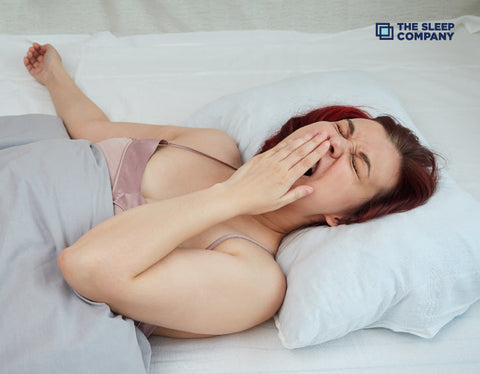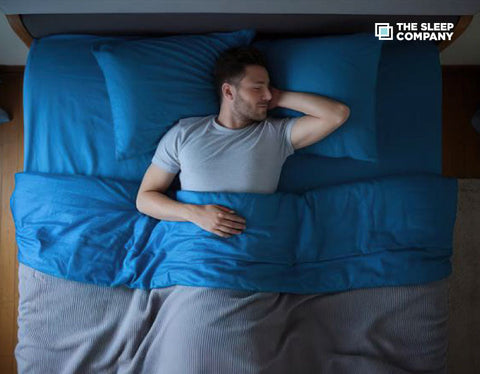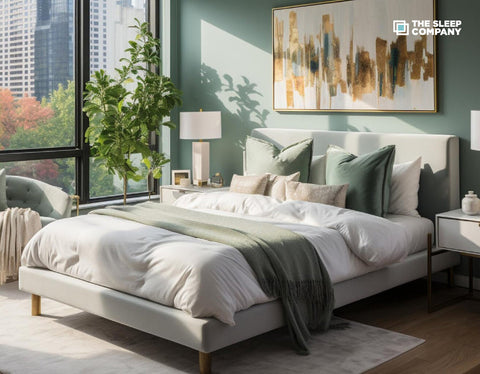My Cart

Yoga Poses For Sleep Apnea

Yoga is an ancient Indian science of holistic wellness. It not only helps calm the mind and the spirit but can be excellent for your overall physical health as well.
One of the main advantages of yoga is that it can be practiced from anywhere. You don’t need a set of equipment or a designated place to make it happen. It is especially useful in this fast-paced era we live in.
But can yoga also benefit sleep disorders like sleep apnea? The answer is yes. While it may not directly treat the condition, it can curb the symptoms to a great extent so you can manage the condition easily.
So, how can you get started? In this article, we bring you yoga poses for sleep apnea that can help you enjoy a good night’s rest without any difficulties. Read ahead to get started!
What Is Sleep Apnea?
Before we proceed, let’s understand a bit about sleep apnea. It is a sleep disorder where you repeatedly stop breathing during your slumber. It happens because the throat muscles relax excessively, blocking the airway. This pause in breathing can lead to loud snoring and tiredness during the day.
Treatment may involve lifestyle changes, devices, or surgery to improve breathing. However, yoga exercises can help you combat the condition to a great extent. Some of the most common symptoms of sleep apnea include:
- Loud snoring
- Abrupt awakenings with choking or gasping
- Excessive daytime sleepiness
- Difficulty staying a sleep
- Morning headaches
- Irritability
- Difficulty concentrating
13 Yoga Poses For Sleep Apnea
Now, let’s look at the easy yet effective yoga poses for sleep apnea. Along with reducing the symptoms, yoga can help you relax and remove any accumulated stress, which can further benefit the condition.

1. Child's Pose (Balasana)
- Kneel on the mat and sit back on your heels
- Now, extend your arms forward and lower your chest toward the ground
- Hold it for a few seconds
- You can do 1-2 sets to begin with
This pose promotes relaxation and can help relieve tension in the back and neck.
2. Cat-Cow Stretch (Marjaryasana-Bitilasana)
- Start on your hands and knees, and alternate between arching and rounding your back
- Flow between the two poses for 1-2 minutes
- Repeat 5-10 rounds
This gentle flow promotes flexibility and can alleviate stiffness in the spine.
3. Legs Up the Wall Pose (Viparita Karani)
- Lie on your back and place your legs up against a wall
- Hold for 5-15 minutes
- Repeat as desired
This pose helps with circulation and relaxation and can reduce snoring. It also promotes better sleep.
4. Corpse Pose (Savasana)
- Lie on your back with arms by your sides, palms facing up
- Hold for 5-15 minutes
This is typically done at the end of a yoga session. Here, focus on deep, rhythmic breathing to calm the nervous system and induce a state of relaxation.
5. Seated Forward Bend (Paschimottanasana)
- Sit with your legs extended in front of you
- Hinge at your hips to reach toward your toes
- Hold for 30 seconds to 1 minute
- Repeat 2-3 times
This pose stretches the spine and may help relieve tension in the upper back.
6. Bridge Pose (Setu Bandhasana)
- Lie on your back, bend your knees, and lift your hips toward the ceiling
- Hold for 30 seconds to 1 minute
- Repeat 3-5 times
This pose strengthens the back and can improve respiratory function.
7. Reclining Bound Angle Pose (Supta Baddha Konasana)
- Lie on your back with the soles of your feet together, knees dropping outward
- Hold for 1-5 minutes
- Repeat 2-3 times
This pose opens the chest and promotes relaxation.
8. Cobra Pose (Bhujangasana)
- Lie on your stomach, place your hands under your shoulders, and lift your chest off the ground
- Hold for 15-30 seconds
- Repeat 2-3 times
The cobra pose stretches the chest and strengthens the back.
9. Thread the Needle Pose (Parsva Balasana)
- Start on your hands and knees, then slide one arm under the other with the shoulder resting on the mat
- Hold for 30 seconds to 1 minute on each side
- Repeat 2-3 times on each side
This pose releases tension in the neck and shoulders.
10. Happy Baby Pose (Ananda Balasana)
- Lie on your back, grab the outer edges of your feet, and draw your knees toward your armpits
- Hold for 30 seconds to 1 minute
- Repeat 2-3 times
This pose stretches the spine and inner thighs.
11. Standing Forward Bend (Uttanasana)
- Stand with feet hip-width apart
- Hinge at the hips and reach toward the ground
- Hold for 30 seconds to 1 minute
- Repeat 2-3 times
Forward bends can calm the mind and release tension in the back.
12. Supported Shoulderstand (Salamba Sarvangasana)
- Use props to support your shoulders as you lift your legs toward the ceiling
- Hold for 1-5 minutes
- Repeat 2-3 times
This inversion can improve blood circulation and reduce snoring.
13. Alternate Nostril Breathing (Nadi Shodhana)
- Sit comfortably
- Use your thumb to block one nostril while inhaling and exhaling through the other
- Switch nostrils and repeat
- Practice for 3-5 minutes
- Make this a daily part of your routine
This breathing exercise promotes balance and relaxation.
Note:
Make sure you perform these poses mindfully and with proper breathing. If you experience any discomfort, stop and consult a healthcare professional or a certified yoga instructor for guidance.
Other Remedies For Sleep Apnea
Apart from yoga poses for sleep apnea, here are a few other remedies to help you overcome the condition.
1. Weight Management
One of the best ways to curb the symptoms of sleep apnea is shedding excess pounds where relevant. Even a small weight loss can bring meaningful relief in some cases. Infact, just losing about 10% weight can also bring relief. However, make sure you follow a nutritious diet and don't starve yourself to achieve your goals.
2. Positional Therapy
Choosing to sleep on your side instead of your back can be a simple yet effective way to prevent the collapse of the airway. This is a common issue in individuals with sleep apnea.
Side sleeping helps keep the throat open and reduces the risk of interruptions to your breathing.
To enhance this approach, you can always make use of specialized Pillows or devices designed to promote side sleeping like body pillows. It can offer additional support. Also, these aids ensure a comfortable and stable side-sleeping position throughout the night, which enables improved airflow and a reduction in sleep apnea symptoms.
3. CPAP Therapy
CPAP is a common sleep apnea fix where you wear a mask over your nose or mouth at bedtime. This nifty device is connected to a machine that keeps a constant flow of air. So, it prevents any airway blockages during sleep.
The mask acts like a gentle airway bodyguard and makes way for a smooth and uninterrupted passage of your breath. Using the device is extremely simple. You slip on the mask, let the machine work its magic, and enjoy a peaceful night's sleep, minus the interruptions caused by your airway acting up. However, speak with your doctor first and only then move forward.
4. BiPAP Therapy
Like CPAP, BiPAP provides relief for sleep apnea. It offers adjustable air pressure levels and can be a comforting option for those who find it challenging to cope with continuous pressure during exhalation.
BiPAP adjusts the air pressure when you breathe in and out. So, it is more adaptable to your breathing patterns. This flexibility enhances comfort and compliance with therapy. Again, you will have to speak with your doctor first to check if it is the right course of action for you.
5. Avoiding Alcohol and Sedatives
When suffering from sleep apnea, it is best to skip alcohol and sedatives, especially right before bedtime. Why? Because they can relax the throat muscles. This relaxation can worsen the condition.
Always look for alternative, non-sedative ways to unwind in the evening. Simple lifestyle changes can go a long way.
6.Quit Smoking
Putting an end to smoking is not just good for sleep apnea but for your overall health. It reduces airway inflammation and fluid retention, both significant factors in tackling sleep apnea.
Quitting smoking also enhances lung function, boosts oxygen levels, and leads to a more restorative sleep.
If your symptoms point towards sleep apnea, it is important to speak with your healthcare provider before you try any remedies. Proper diagnosis is the first step!
Conclusion
Sleep apnea can be combatted with a few lifestyle changes as mentioned earlier. You can also include yoga poses for sleep apnea in your regular exercise routine to help manage the symptoms to a great extent.
As you know, sleep apnea can lead to sleep disturbances and can affect the quality of life. So, along with professional treatment, diagnoses, and the right home remedies like yoga poses for sleep apnea, it's also important that you get proper beds.
Recliner beds are ideal for someone with sleep apnea. It allows you to elevate the upper body, which can be helpful for individuals with sleep apnea, especially those with positional obstructive sleep apnea. This position may reduce snoring and improve airflow.
If you are looking for the best recliner bed, The Sleep Company's Elev8 can be perfect for you. Recliner mode, Zero Gravity mode, and Dual Massager mode are some of the features it offers. It is an advanced bed designed to improve your sleep quality and daily comfort.
Choose the right comfort and support today!


































































